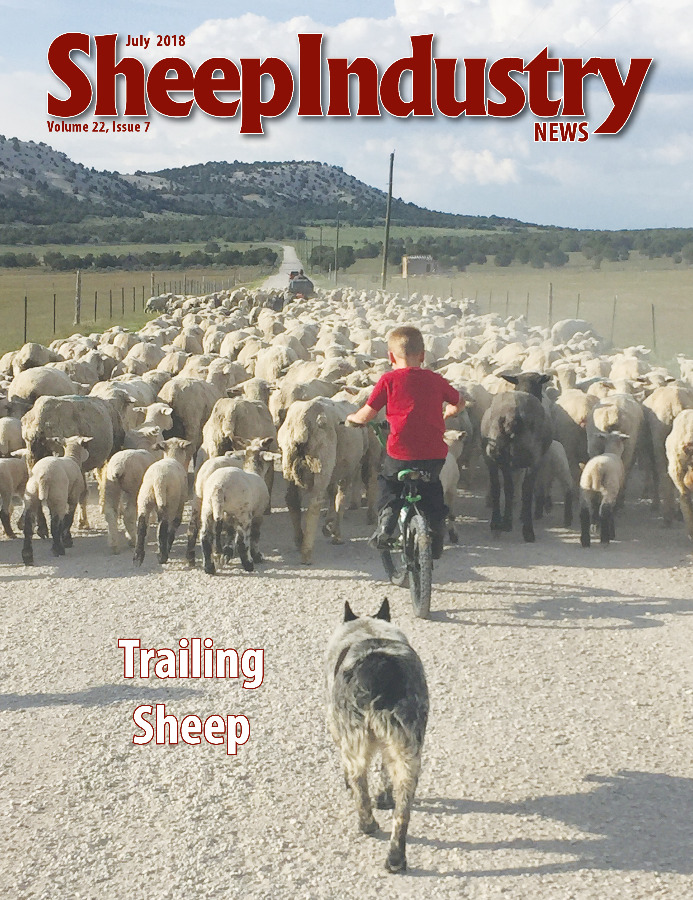
- July 2018
- President’s Notes
- Exports Drive Market for American Wool Producers
- Family Matriarch: Jeanne Siddoway
- IWTO’s 87th Congress Tackles Wool Sustainability
- NSIIC Budgets Funds for 2018 Grant Proposals
- Young Entrepreneur: Brady Campbell
- ASI News
- Around the States
- Obituary: Ernest “Bud” Gutzman
- Market Report
- Genetic Scrapie Resistance in Goats
- The Last Word
New Tool: Genetic Scrapie Resistance in Goats
Stephen N. White, Ph.D., & David A. Schneider, DVM, Ph.D., DACVIM (LAIM)
Special to the Sheep Industry News
Scrapie eradication requires a joint effort in sheep and goats. Genetic scrapie resistance has been an important tool available to the sheep industry but not to goat industries – until recently.
Two goat prion gene alleles have now been shown to confer resistance to classical scrapie. They are S146 (serine [S] amino acid at prion protein position 146), and K222 (lysine [K] at position 222). Goats bearing just a single copy of either one of these alleles have been strongly resistant to infection during natural outbreaks, as well as direct challenge experiments.
In the last 15 years (2002-2017), the European Union has recorded more than 10,500 cases of scrapie in goats. To address this problem for eradication, the European Commission formally requested that the European Food Safety Authority evaluate the strength of evidence for genetic scrapie resistance in goats. The EFSA brought together a panel of European experts to conduct a comprehensive review of research. In its recently published review, the panel concluded that today’s evidence for genetic resistance conferred by the S146 and K222 alleles in goats exceeds the evidence that was available for R171 when it was recommended for resistance in sheep. Thus, the commissioned review recommended the use of genetic scrapie resistance in goats to augment eradication programs.
Rules for implementing goat genetics in scrapie eradication programs were left to each European country to develop, but final rules are not yet available. While scrapie resistance alleles in goats have not been formally recognized in the United States, the National Scrapie Eradication Program plans to conduct a herd cleanup pilot project in goats based on S146 and K222 goat alleles similar to that done for sheep in the early days of genetic resistance in sheep.
Goat DNA testing services for S146 and K222 alleles are available at the Veterinary Genetics Laboratory of the University of California-Davis. Details may be found at https://www.vgl.ucdavis.edu/services/GoatScrapie.php. Reduced pricing has been arranged for testing done through VGL for members of two of the largest goat organizations (the American Dairy Goat Association and the American Boer Goat Association).
Similarly, testing services are in development at NeoGen Genomics, Inc. (GeneSeek). Service details will be available at this website: http://genomics.neogen.com/en/research-and-development-genomic-discovery#sheep-and-goat. The U.S. Department of Agriculture has not established an approval process for laboratories to conduct official scrapie susceptibility genotyping in goats, so testing at either lab would not be considered official testing for regulatory purposes.
Both S146 and K222 are naturally occurring alleles in American goats. The S146 allele is common in American goats and has been identified in seven of 10 breeds of both meat and dairy types, including: Boer, Tennessee fainting goats (myotonic), Nubian, Alpine, Saanen, LaMancha, and Pygmy goats. Among these breeds, the S146 allele is particularly common in Boer and Nubian goats. S146 is probably present in additional breeds and will likely be found as larger numbers of goats from those breeds get tested.
The K222 allele is most often observed in dairy breeds. One United States study identified it in Toggenburg and LaMancha goats. Other studies have identified K222 in most European descended breeds, including Alpine, Saanen, and Anglo-Nubian. The K222 allele is probably present in additional breeds, too, and will be found as larger numbers of goats from those breeds get tested.
As with sheep, goat producers are encouraged to maintain overall herd health, productivity and reduce inbreeding by selecting goats superior for many traits (not only scrapie resistance) and from diverse families. By using such measures, goat producers can boost or add scrapie resistance while continuing to improve all other aspects of goat breeding quality. Overall, breeding for strong scrapie resistance in goats, as well as in sheep, will provide one more tool to combat scrapie.
Mention of trade names or commercial products in this publication is solely for the purpose of providing specific information and does not imply recommendation or endorsement by the USDA to the exclusion of others that may also be suitable. USDA is an equal opportunity provider and employer.

